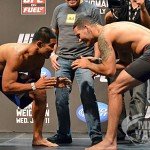The fall and rise of karate in MMA
It’s odd how quickly the sport of MMA has changed, and how perceptions have shifted so dramatically. I got in on the ground floor of this crazy train, having seen an ad for UFC 1 in one of several karate publications I read as a young martial artist. I had entered the world of karate as a boy, partially to be more like my older brother, but primarily because I always wanted to kick people’s asses. Mike Tyson having begun to fade into “Bolivian” at the time, guys like Jean-Claude Van Damme and Steven Seagal were the new bad asses of our era, and if you wanted to lay an ass kicking on schoolyard thugs, you needed a black belt ASAP.
When UFC 1 came around, I was in the 99% of people who had never heard of Brazilian Jiu-jitsu, and was much more interested in what style of karate would prevail against other styles. As such, early UFC proved both confusing and somewhat frustrating, as guys like Royce Gracie and Dan Severn were the ones dishing out all the beatings, and all of the karateka of that era were reduced to jokes in the face of “proven” martial styles.
Yet today we see a resurgence of karate in the MMA world, with fighters like Lyoto Machida, Lyman Good and John Makdessi not only fighting as unapologetic karateka, but actually winning. An isolated occurrence perhaps, but with not one but two karateka finding their way into The Ultimate Fighter cast this year, I think it’s time to take a look at the fall and rise of karate in MMA.
To understand where these new breed of karateka are coming from, we need to look at how Karate has changed in the US over the years.
Post WW2 to 1980′s
For the most part, karate found it way into the US on the heels of returning soldiers from the Pacific theater of World War 2. With time being spent securing the Japanese islands and no war to be fought anymore, active duty soldiers found themselves a bit stir-crazy, but still with plenty of aggression to work out of their systems. With these men being in close proximity to the surrendered Japanese military, they found themselves involved in their former enemies training routines, and thereby introduced to the world of Japanese martial arts, or karate. Judo, Jiu-jitsu, and Kiyoshin-Kai became a favored past-time of these American soldiers, who then brought this skill back to the US.
With US forces taking root in Korea as well several years later, and the natural flow of servicemen back to the US, many of these men established dojos as a small side business. These men taught karate the way they learned it, as a hard-nosed and physically demanding style centered around results and brutal efficiency. This would begin to shift as David Karidean and Bruce Lee came on the scene, and these teachers discovered there was serious money to be made on the kung-fu fad, as the Chinese were still unwilling to teach Westerners.
1980′s to TUF
Depending on who you ask, the greatest or worst thing to happen to karate was the blockbuster movie The Karate Kid. This movie instantly put karate on the map as “cool” and skyrocketed enrollment in dojos across the board. This created a rift in karate, where some men wanted to stick to the traditional and oftentimes brutal style of karate they had always taught, while others realized the vast majority of 1980′s children weren’t equipped to handle that.
Over the course of time, the schools that centered around physically demanding and brutal hand-to-hand combat would become the minority, in favor of a fluffier business-style karate. My older brother went from karate student to a police combative instructor and is fond of the saying “Karate schools are half daycare and half yuppie fantasy camp,” because of that shift in teaching styles to pick up on this rush of new business. With classes tailored more towards self-confidence rather than legitimate fighting skills, this left a major rift in the amount of people with athletic or competitive goals in mind from setting foot in the dojo.
So what changed? The Ultimate Fighter.
In a bizarre turn of events, The Ultimate Fighter had the exact opposite effect of The Karate Kid. Now there were young men who didn’t care about nunchukus and belts, but about triangle chokes and overhand rights, and that fake karate crap wasn’t going to cut it. Suddenly, every dojo had MMA classes to cash in on this new phenomenon, and there was a new rush for everyone to go train some “ultimate fighting”. Anyone that knows anything about MMA knows those overnight MMA dojos haven’t turned out any real notable fighters. So, where are these guys coming from? The answer is two-fold:

Lyoto Machida
That which is old is new again
The odd thing is, some of those pre-Karate Kid schools never went away. Those Pacific theater GIs were able to battle-harden plenty of men following the war, and those men had sons. A common link in this Karateka invasion are young men who grew up learning legitimate karate skill, and who have jumped ship from point fighting and kickboxing to try their hand at a serious career in MMA. Men like Lyoto Machida and Steven Thompson are prime examples of father to son training leading to world-class accomplishment in combat sports. Rather than learning the bulk of their skill inside an MMA gym, they show up as a finely honed razor and work towards adapting their style to work inside the world of MMA
The other factor for karateka’s making an impact is not so much the teaching methods, but the people attracted to karate. The karate of the last 30 years has largely revolved around self-confidence, discipline and the idea of self-defense through counter-attacking someone. It lacks physically demanding work, a real competitive spirit or any sort of intensity. It’s this formula that allows literally anyone to walk into a dojo and achieve black belt status in a short amount of time. While this formula works in a business sense, it’s the exact opposite set-up that an athlete is looking for, and young men have traditionally drifted towards team sports, boxing and wrestling, rather than karate.
With the explosion of MMA, this has changed how people view martial arts, and athletic future MMA fighters are finding their way into traditional karate schools. This often appears to be due to geography, but these men can make the traditional style work for them in the same way it worked in the old school karate world.
A different kind of striker
A majority of MMA fighters are from an MMA striking background, meaning they learned to fight inside the MMA gym, picking up a boiled down version of muay thai and boxing. The other major demographic are men that learned boxing or muay thai in an actual dedicated gym for said style, and have then adapted this to MMA. This functionally boils down to a set series of attacks, with the only difference being in the execution of those attacks. Leg kicks, jabs, straights and hook punches account for nearly all the standing offense in MMA, with a few fighters adding front kicks, uppercuts and shovel hooks to their tool bag.
Karate is a different beast all together, which is why it’s so difficult to deal with at the higher levels. The punches originate from different angles and sneak around the guard. The kicks primarily come off of the front leg and have far more variety than your typical striker. The stance leaves few targets exposed and makes the karateka fleet of foot, allowing him to zip in and out of range and come in with hard strikes.
Karateka share an advantage in match-making as well, in that it’s difficult to find high-level karateka to train against. This leaves opponents walking into an uncomfortable situation where they need to adjust on the fly and can’t always put it together during the fight. This is highlighted by Machida’s initial run in the UFC, where opponents would walk back to their corner declaring “He’s just running from me!” yet they were battered and bleeding from Machida’s low-risk attack plan.
In the future….
It’s hard to say where this influx of karateka will go, as it greatly depends on the success of those in the spotlight. As more MMA gyms open and the “old guard” of karate becomes tapped out, earning your black belt will be that much more distinctive in the MMA world. As long as fighters are getting knocked out with front kicks and reverse punches, there will always be that young man who takes up the gi and attempts to bring some Eastern lethality back into the cage.
Category: Exclusive, Featured, MMA, Opinion, UFC, Ultimate Fighter











Like the perspective :) great reading you sir
Thank you Chris, don’t be a stranger to the site.
Excellent well-written article. You present your viewpoints with a clarity and objectivity that is rarely encountered in MMA-related blogs and publications. Although I am not a huge MMA supporter, I certainly acknowledge the tremendous skill and high level of athleticism one needs to excel in that demanding profession. As a Goju student for 10 years, I also appreciate the applicability of BJJ techniques in all types of fighting situations (competitive and real-life) and the importance of a strong “ground game”. The one tragedy for MMA enthusiasts is the taxing effect that its intense training system has on the human body. It is truly a young man’s game and not something that we 40+ GenXers can pursue into our advancing years. The only other objection I have is the MMA culture which has festered with the advent of reality television. Many people associated with UFC and other groups come across as testosterone-driven alpha males with shaved heads, tats galore and piercings in every crevice. Not exactly the kind of men I want my daughter to bring home, but I trust they represent a minority of the population of MMA Nation. That all said, I love this article and genuinely applaud the reasons why you support both MMA and karate.
@ Mike Paquet:
Thanks for reading!
I’ve gotta point out, old style karate training is just as taxing on the body as anything going on in an MMA gym today. My first school was an inner city dojo where the sensei was more interested in beating an ounce of discipline into kids as he was in teaching anything useful. If that guy was still running it like that today, he’d be in jail, but it got some key points across to me.
As for the “TUF generation” as we refer to those tough guys you mentioned, they’re more or less gone at this point. As with any counter-culture movement or fad, 90% of people are into it for the wrong reasons. Most of those guys have long since become bored with pretending to train and moved on to other things. Still meatheads around, but generally a pretty tame crowd these days.
Thank you for the kind words and make sure you check out RFA this weekend if you have the chance, to see some legitimate karate on display from Justin Lawrence.